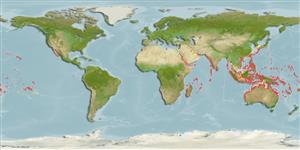分类 / Names
俗名 | 同种异名 | Catalog of Fishes(属, 种) | ITIS | CoL | WoRMS | Cloffa
Teleostei >
Eupercaria/misc (Various families in series Eupercaria)
鱸形目 (Various families in series Eupercaria) >
Labridae (Wrasses)
隆頭魚科 (Wrasses) > Corinae
Etymology: More on author: Rüppell.
Environment: milieu / climate zone / depth range / distribution range
生态学
海洋 礁区鱼类; 深度上下限 3 - 30 m (Ref. 1602). 热带; 36°N - 35°S, 25°E - 112°W
Indo-West Pacific: Red Sea and South Africa, including the southeast coast (Ref. 4392) to Easter Island, north to Japan (Ref. 38029), south to Australia. Not found in the Hawaiian Islands, but replaced by the closely related Anampses cuvier.
印度-太平洋: 到复活岛的红海与南非 (参考文献 4392),北至台湾, 南至澳洲。 不出现在夏威夷群岛, 但是被接近地讲的 Anampses cuvier 取代了. 东南大西洋: 南非的东南海岸.(参考文献 4392)
大小 / 重量 / 年龄
Maturity: Lm ? range ? - ? cm
Max length : 42.0 cm TL 雄鱼/尚未辨别雌雄; (Ref. 30573)
背棘 (总数) : 9; 背的软条 (总数) : 11 - 13; 臀棘: 3; 臀鳍软条: 11 - 13. This species is distinguished by the following characters: 27 lateral-line scales; 18-25 gill rakers; mid-dorsal region of nape is naked or with small deeply embedded scales continuous across the dorsal part of nape (more apparent in dried specimens); relatively elongate body with depth 2.3-3.2 in SL; body width 2.2-2.7 in depth; head length (HL) 2.6-3.1 in SL; snout 2.3-2.7 in HL; eye 2.6-3.7 in snout; flexible dorsal spines; caudal fin truncate to slightly rounded; pectoral fins 1.6-1.9 in HL; pelvic fins 2.1-2.5 in HL. Body colour of Initial Phase (IP): brown to orange-brown, a dark edged pale blue spot on each scale; head reddish-brown to orange-brown, with dark-edged narrow blue bands; dorsal fin brown to brownish-red with small dark-edged blue spots, a narrow blue margin and black submarginal line; anal fin brownish-red to red and 2 or 3 rows of small dark-edged blue spots, a narrow blue margin, and black submarginal line; caudal peduncle with reddish hue on upper and lower margins; caudal fin brown to reddish-brown with small dark-edged blue spots and blue margins; pectoral base with a dusky orange-red bar, edged in blue, the upper portion blackish. Colour of Terminal Phase (TP): each scale of body olive with a dark-edged blue vertical line (except on thorax, abdomen, and nape where the blue segments are shorter and variously oriented); head with irregular, narrow, dark edged, blue bands, a broad blue band across anterior interorbital space; most individuals with a broad light green bar on side centered on sixth dorsal spine, the area anterior to this and the region of the nape coloured reddish to reddish-brown; dorsal and anal fins reddish with broad margins and basal stripes of bright blue, dorsal with a median band of small dark-edged blue spots and the anal with one or two blue stripes in middle of fin; reddish caudal fin with prominent blue margins and blue stripes along rays, but with an upper and lower zone of fin largely free of blue; pectoral base with an orange or orange-brown blue-edged bar, the upper portion of which is blackish. It has been reported that during courtship, the blue band between the eyes and around the mouth, and the single light green bar on the body of the male became brighter (Ref. 94255).
头部有狭窄的黑色边的蓝色条纹; 雄鱼通常有横过前面的眼间隔的一个宽的地带。 在身体有上的鳞片黑色边的浅蓝色斑点 (母鱼) 或垂直的线 (雄鱼). 雌性形式褐色的颜色, 红褐色的腹地; 雄鱼形成橄榄色。 在胸鳍基底上的边缘蓝色的横带暗色的橘红色的母鱼, 橘色的到暗色的在雄鱼中。 背棘柔韧有弹性的。 尾鳍截形略圆的。
Adults are found on the surge zone of coral reefs or rocky coasts (Ref. 9710, 58534). They occur singly or in pairs (Ref. 9710). Tiny juveniles swim with head towards the bottom and slowly undulate the body, looking like a floating leaf in the current (Ref. 48636). Young feed primarily on small crustaceans and polychaetes, adults switch to larger crustaceans and mollusks as well as polychaetes (Ref. 1602). They bury at night (Ref. 9710). Oviparous, distinct pairing during breeding (Ref. 205). Occasionally trawled (Ref. 30573). Not common in fish markets. Minimum depth reported taken from Ref. 30874.
栖息于珊瑚礁的涌浪区或岩石的海岸了。 (参考文献 9710) 各别地或成对生存。 (参考文献 9710) 极小的稚鱼与对于底部的头部一起游泳而且慢慢地波动身体, 看起来像在水流中的一片漂浮的叶.(参考文献 48636) 幼鱼主要捕食小型甲壳动物与多毛类动物, 成鱼转变成较大的甲壳动物与软件动物以及多毛类动物.(参考文献 1602) 埋藏它本身在晚上。 (参考文献 9710) 偶然地拖网捕获。 (参考文献 30573) 不常见于鱼市场。 最小深度报告取自参考文献 30874.
Life cycle and mating behavior
Maturities | 繁殖 | Spawnings | Egg(s) | Fecundities | 仔鱼
Oviparous, distinct pairing during breeding (Ref. 205).印度-太平洋: 到复活岛的红海与南非 (参考文献 4392),北至台湾, 南至澳洲。 不出现在夏威夷群岛, 但是被接近地讲的 Anampses cuvier 取代了. 东南大西洋: 南非的东南海岸.(参考文献 4392)
Westneat, M.W., 2001. Labridae. Wrasses, hogfishes, razorfishes, corises, tuskfishes. p. 3381-3467. In K.E. Carpenter and V. Niem (eds.) FAO species identification guide for fishery purposes. The living marine resources of the Western Central Pacific. Vol. 6. Bony fishes part 4 (Labridae to Latimeriidae), estuarine crocodiles. FAO, Rome. (Ref. 9823)
人类利用
渔业: 低经济; 水族馆: 商业性
工具
特别资料
下载 XML
网络资源
Estimates based on models
Preferred temperature (Ref.
123201): 24.7 - 29.3, mean 28.2 °C (based on 2920 cells).
Phylogenetic diversity index (Ref.
82804): PD
50 = 0.5002 [Uniqueness, from 0.5 = low to 2.0 = high].
Bayesian length-weight: a=0.00977 (0.00470 - 0.02030), b=3.07 (2.89 - 3.25), in cm total length, based on LWR estimates for this (Sub)family-body shape (Ref.
93245).
营养阶层 (Ref.
69278): 3.4 ±0.42 se; based on food items.
回复力 (Ref.
120179): 中等的, 族群倍增时间最少 1.4 - 4.4年 (Preliminary K or Fecundity.).
Fishing Vulnerability (Ref.
59153): Low to moderate vulnerability (32 of 100).
Nutrients (Ref.
124155): Calcium = 43.9 [26.8, 68.9] mg/100g; Iron = 0.552 [0.328, 0.983] mg/100g; Protein = 18.6 [15.7, 20.8] %; Omega3 = 0.128 [0.087, 0.189] g/100g; Selenium = 29.2 [18.3, 49.1] μg/100g; VitaminA = 97.6 [31.4, 331.3] μg/100g; Zinc = 1.33 [0.97, 2.06] mg/100g (wet weight);
